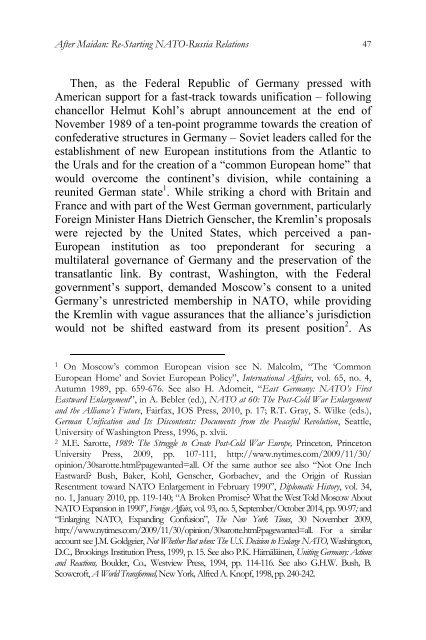beyondukraine.euandrussiainsearchofanewrelation
beyondukraine.euandrussiainsearchofanewrelation
beyondukraine.euandrussiainsearchofanewrelation
Create successful ePaper yourself
Turn your PDF publications into a flip-book with our unique Google optimized e-Paper software.
After Maidan: Re-Starting NATO-Russia Relations 47<br />
Then, as the Federal Republic of Germany pressed with<br />
American support for a fast-track towards unification – following<br />
chancellor Helmut Kohl’s abrupt announcement at the end of<br />
November 1989 of a ten-point programme towards the creation of<br />
confederative structures in Germany – Soviet leaders called for the<br />
establishment of new European institutions from the Atlantic to<br />
the Urals and for the creation of a “common European home” that<br />
would overcome the continent’s division, while containing a<br />
reunited German state 1 . While striking a chord with Britain and<br />
France and with part of the West German government, particularly<br />
Foreign Minister Hans Dietrich Genscher, the Kremlin’s proposals<br />
were rejected by the United States, which perceived a pan-<br />
European institution as too preponderant for securing a<br />
multilateral governance of Germany and the preservation of the<br />
transatlantic link. By contrast, Washington, with the Federal<br />
government’s support, demanded Moscow’s consent to a united<br />
Germany’s unrestricted membership in NATO, while providing<br />
the Kremlin with vague assurances that the alliance’s jurisdiction<br />
would not be shifted eastward from its present position 2 . As<br />
1 On Moscow’s common European vision see N. Malcolm, “The ‘Common<br />
European Home’ and Soviet European Policy”, International Affairs, vol. 65, no. 4,<br />
Autumn 1989, pp. 659-676. See also H. Adomeit, “East Germany: NATO’s First<br />
Eastward Enlargement”, in A. Bebler (ed.), NATO at 60: The Post-Cold War Enlargement<br />
and the Alliance’s Future, Fairfax, IOS Press, 2010, p. 17; R.T. Gray, S. Wilke (eds.),<br />
German Unification and Its Discontents: Documents from the Peaceful Revolution, Seattle,<br />
University of Washington Press, 1996, p. xlvii.<br />
2 M.E. Sarotte, 1989: The Struggle to Create Post-Cold War Europe, Princeton, Princeton<br />
University Press, 2009, pp. 107-111, http://www.nytimes.com/2009/11/30/<br />
opinion/30sarotte.html?pagewanted=all. Of the same author see also “Not One Inch<br />
Eastward? Bush, Baker, Kohl, Genscher, Gorbachev, and the Origin of Russian<br />
Resentment toward NATO Enlargement in February 1990”, Diplomatic History, vol. 34,<br />
no. 1, January 2010, pp. 119-140; “A Broken Promise? What the West Told Moscow About<br />
NATO Expansion in 1990”, Foreign Affairs, vol. 93, no. 5, September/October 2014, pp. 90-97; and<br />
“Enlarging NATO, Expanding Confusion”, The New York Times, 30 November 2009,<br />
http://www.nytimes.com/2009/11/30/opinion/30sarotte.html?pagewanted=all. For a similar<br />
account see J.M. Goldgeier, Not Whether But when: The U.S. Decision to Enlarge NATO, Washington,<br />
D.C., Brookings Institution Press, 1999, p. 15. See also P.K. Hämäläinen, Uniting Germany: Actions<br />
and Reactions, Boulder, Co., Westview Press, 1994, pp. 114-116. See also G.H.W. Bush, B.<br />
Scowcroft, A World Transformed, New York, Alfred A. Knopf, 1998, pp. 240-242.


